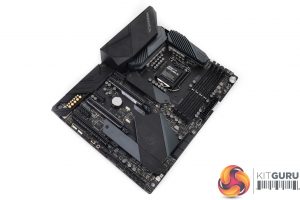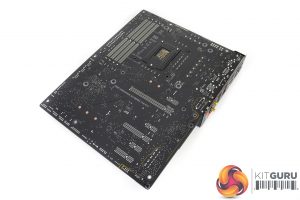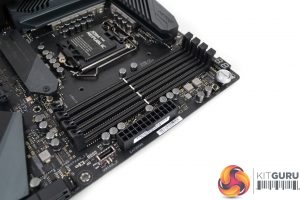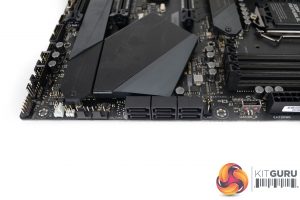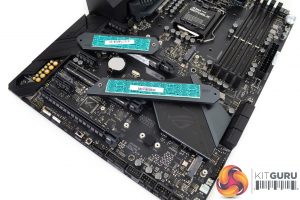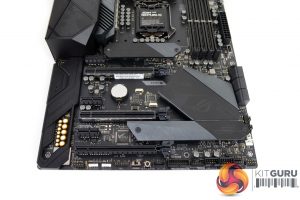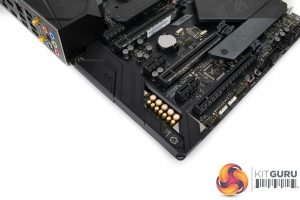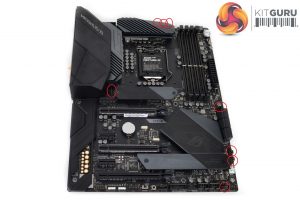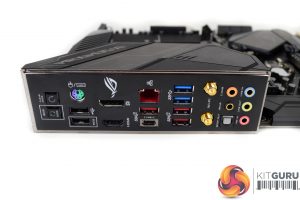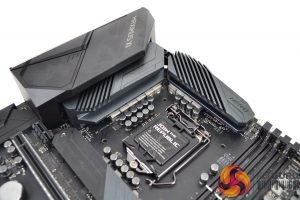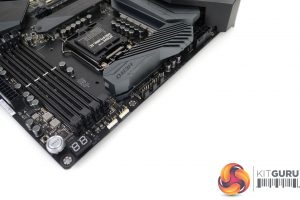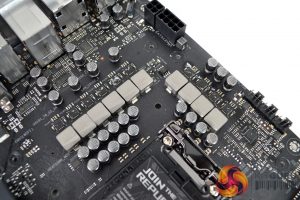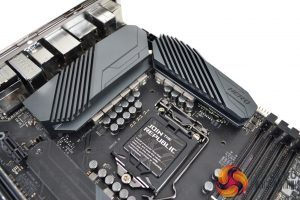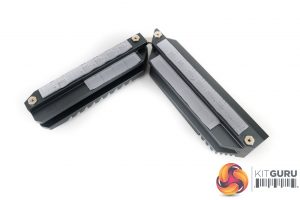A deep-black appearance is contrasted by subtle elements of grey on neighbouring heatsinks. ASUS opts for this colour-neutral appearance so that the RGB LEDs housed within the integrated IO shield and PCH heatsink can add flare to a user's preferred shade. Consistent deviations in the form of silver-topped electronics and solder traces may offend styling purists. With that said, we do not see many areas where there can be complaint for ASUS' well-balanced styling approach.
Chunky SafeSlot connectors are used for the two primary full-length PCIe slots. Music to the ears of those battling the concern of GPU sag.
Two individual RGB LED zones create a discontinuous, contoured lighting appearance. The PCH heatsink is home to ASUS' iconic ROG logo while the rear IO zone sits beneath the non-illuminated Maximus XI product marking. Personally, I like the subtleness of ASUS' RGB lighting approach. However, others may prefer the more all-in LED offerings from competing vendors.
No less than four RGB headers are present on the Hero. Half are assigned as 4-pin RGB connections while the other two are 5V addressable alternatives. I like ASUS' decision to position two headers, one 4-pin and one addressable, close to the CPU socket and within reach of roof-mounted LED strips or fans.
Up to 64GB of dual-channel DDR4 memory can reside in the quartet of single-latch DIMM slots. ASUS quotes frequency support of up to 4400MHz. That number is heavily dependent on factors such as DRAM chip layout on the DIMM, CPU IMC strength, and BIOS stability.
Onboard power and reset buttons sit next to two-digit diagnostic LED. Both of these features continually prove their worth for early- and late-stage troubleshooting both inside and outside of a chassis.
All six SATA 6Gbps ports operate from the Z390 chipset. The inclusion of six ports is likely to be sufficient for most of this motherboard's audience. However, there's no denying that including the bare minimum number of ports from the Z390 chipset is measly by ASUS, especially on a close-to-£300 product.
Thankfully, only one SATA 6Gbps port is disabled when an M.2 SATA SSD is installed in the top M.2 slot. There is no disabling of SATA ports when an M.2 PCIe SSD is installed in either of the motherboard's two positions, which is positive.
A single USB 3.1 Gen 2 connector permits high-speed connectivity to supported front panel devices. There's no internal USB 3.0 header on the right edge. This will be less-than-ideal to users whose case forces them to stretch the thick cable down to ASUS' bottom-edge location.
ASUS opts to include two 32Gbps PCIe-capable M.2 slots. The top one also features support for SATA 6Gbps SSDs but its physical compatibility is reduced to a maximum of 80mm-long drives, as opposed to 110mm options that the bottom slot will handle. Positioning is the usual affair and shouldn't cause too many installation headaches unless you use a large CPU cooler in addition to a pair of dual-slot graphics cards.
While it's hard to argue with a pair of M.2 slots, many competing vendors' boards in this price range crank the slot count up to three. Only the most eager of storage enthusiasts will want triple PCIe SSDs in their build. However, there's no reason why enthusiast gamers won't want a couple of PCIe SSDs operating alongside an M.2 SATA offering. The Hero cannot provide such luxury and will instead force users to cable-up a standard 2.5″ SSD.
Provided the components on your SSD are aligned with the thermal pad on ASUS' heatsink, the sturdy slabs of metal should have no problems whipping a few Watts of heat away from even the most toasty of M.2 devices.
Up to two graphics cards can run in multi-GPU operation thanks to ASUS' bifurcation of the LGA 1151v2 CPU's sixteen PCIe 3.0 lanes. Spacing between the primary expansion slots is ideal. The open-ended design of all three PCIe 3.0 x1 slots is another nice feature for those who want to Frankenstein a physically larger expansion card into somewhere it shouldn't fit.
That bottom full-length PCIe slot runs at Gen 3.0 x2 mode by default, but can provide an additional two lanes of bandwidth if two SATA 6Gbps connectors are disabled. Its PCIe lanes are derived from the Z390 chipset and therefore will not steal precious links from the CPU. One caveat of ASUS' chosen lane distribution is that DMI-infused bandwidth headaches will quickly become prevalent if a high-speed network or RAID card is installed alongside multiple M.2 PCIe SSDs.
That situation is unlikely to be a problem for most of this motherboard's audience.
ASUS' ROG SupremeFX audio system is based around the Realtek ALC1220 codec. Alongside a bank of audio-grade capacitors is a premium ESS ES9023P DAC. The audio system is compatible with ASUS' OS-based software suites.
Compatibility with fans is one of the key strengths for the Hero. ASUS includes no less than eight (!) fan headers, all of which are 4-pin and UEFI controllable. All headers can output 12W (1A) of power, except for the W_PUMP+ and H_AMP connectors which are bolstered to 36W (3A).
Positioning of these headers is ideal, with distribution between the upper- and lower-halves of the board proving well-thought.
No major complaints to report for ASUS' choice of rear IO ports. A couple of USB 2.0 ports for keyboard and mouse support is ideal, and there's no harm in an added pair of 5Gbps USB 3.0 Type-A connections. Four 10Gbps USB 3.1 Gen 2 ports are present, one of which is supplied in Type-C form.
A single Intel I219-V Gigabit Ethernet port accompanies the Intel Wireless AC 9560 802.11ac chipset to form the motherboard's networking options. While the 1.73Gbps-capable 2×2 MU-MIMO WiFi card is undeniably slick, multi-NIC competitors exist at this price point, as do options with 2.5Gbps Ethernet ports.
Audio ports accompany the mandatory HDMI 1.4 and Displayport 1.2 connectors to round out the selection of rear IO ports.
ASUS supplements the 8-pin EPS connector with a 4-pin CPU power port. This is unlikely to be necessary for most scenarios but there's no harm in users being afforded the extra peace of mind.
The motherboard VRM features ten physical phases, eight of which are allocated for CPU duties. There is a caveat, however, as the Digi+ ASP1400CTB controller is a basic component in ASUS' arsenal that is commonly found on lower-end motherboards, as my colleague Ryan describes.
That basic controller is only capable of managing four phases for the CPU. Typically, this would not be a problem as phase doublers would be introduced to duplicate a single PWM signal from the master controller into two usable signals for the electronic components. This is not ASUS' approach, though.
Instead, four PWM phases are used to control eight sets of VRM hardware. ASUS doubles up the electronic components to a level that we would normally associate with an eight-phase design, but only four driving phases are present. As such, we can call this solution a ‘modified‘ or ‘unique‘ four-phase design (even though ASUS would argue that it is a ‘real‘ eight-phase system due to its eight sets of electronic components).
Despite the use of decent integrated MOSFET packages – Vishay SiC639 50A units – the four-phase system is severely limited in terms of control granularity due to the parallel configuration of the eight sets of electronic components. This is a setup that we would associate with lower-cost offerings, not a premium Z390 motherboard that could viably be partnered with Intel's power-hungry Core i9-9900K CPU.
A large pair of metal slabs are joined together using a flattened heatpipe to form ASUS' VRM heatsink. Mass is certainly on the side of ASUS' hefty unit, and there has been an attempt to create additional surface area by using slots (albeit that could be an aesthetic decision).
Comparing ASUS' heatsink to that of the similarly-priced Gigabyte Z390 Aorus Master, it is clear to see the latter has been designed from the ground up for thermal performance.
Jumping back to the Hero's four-phase VRM topic, the limited control granularity could manifest itself as additional heat output by way of inefficient MOSFET operating currents. That's a far from ideal situation for ASUS' heatsink that has clearly been designed for aesthetics first and cooling second.
It is disappointing to see ASUS making questionable design choices on the power delivery solution of a premium Z390 motherboard. Subtle tweaks in the form of phase doublers or a better-designed MOSFET heatsink would have made little difference to the cost of a motherboard that's pushing close to £300 at retail.
 KitGuru KitGuru.net – Tech News | Hardware News | Hardware Reviews | IOS | Mobile | Gaming | Graphics Cards
KitGuru KitGuru.net – Tech News | Hardware News | Hardware Reviews | IOS | Mobile | Gaming | Graphics Cards


